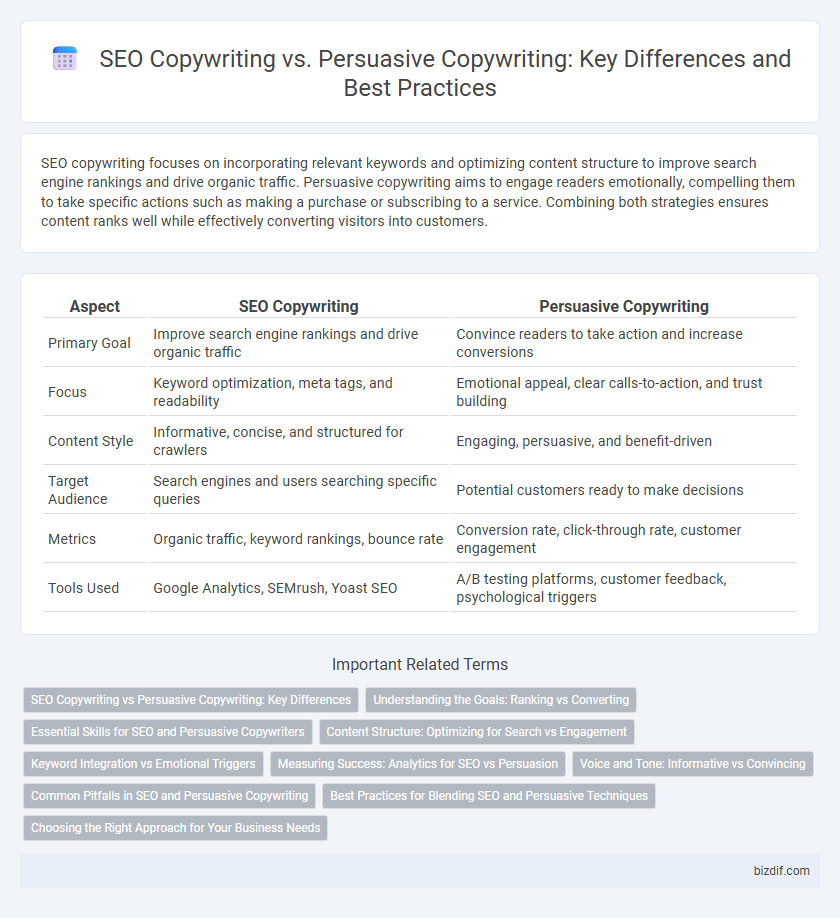SEO copywriting focuses on incorporating relevant keywords and optimizing content structure to improve search engine rankings and drive organic traffic. Persuasive copywriting aims to engage readers emotionally, compelling them to take specific actions such as making a purchase or subscribing to a service. Combining both strategies ensures content ranks well while effectively converting visitors into customers.
Table of Comparison
| Aspect | SEO Copywriting | Persuasive Copywriting |
|---|---|---|
| Primary Goal | Improve search engine rankings and drive organic traffic | Convince readers to take action and increase conversions |
| Focus | Keyword optimization, meta tags, and readability | Emotional appeal, clear calls-to-action, and trust building |
| Content Style | Informative, concise, and structured for crawlers | Engaging, persuasive, and benefit-driven |
| Target Audience | Search engines and users searching specific queries | Potential customers ready to make decisions |
| Metrics | Organic traffic, keyword rankings, bounce rate | Conversion rate, click-through rate, customer engagement |
| Tools Used | Google Analytics, SEMrush, Yoast SEO | A/B testing platforms, customer feedback, psychological triggers |
SEO Copywriting vs Persuasive Copywriting: Key Differences
SEO copywriting focuses on embedding relevant keywords and optimizing content structure to improve search engine rankings, while persuasive copywriting aims to evoke emotions and drive specific actions from the audience. SEO copy emphasizes metadata, keyword density, and readability to attract organic traffic, whereas persuasive copy centers on compelling calls-to-action and storytelling techniques to increase conversions. Understanding these differences is crucial for businesses seeking to balance search visibility with audience engagement.
Understanding the Goals: Ranking vs Converting
SEO copywriting focuses on optimizing content with targeted keywords and search intent to improve website ranking on search engines, driving organic traffic. Persuasive copywriting aims to engage readers emotionally and logically, encouraging them to take specific actions such as making a purchase or signing up. Understanding these distinct goals--ranking for SEO versus converting for persuasion--allows marketers to craft content that both attracts visitors and motivates engagement effectively.
Essential Skills for SEO and Persuasive Copywriters
SEO copywriters must master keyword research, on-page optimization, and an understanding of search engine algorithms to boost organic traffic effectively. Persuasive copywriters excel in emotional appeal, storytelling techniques, and clear calls-to-action to drive conversions and engage audiences. Both require strong writing skills, audience analysis, and adaptability to align content with strategic marketing goals.
Content Structure: Optimizing for Search vs Engagement
SEO copywriting prioritizes a content structure rich in relevant keywords, headers, and metadata to improve search engine rankings and enhance discoverability. Persuasive copywriting emphasizes emotional triggers, storytelling, and clear calls-to-action to maximize reader engagement and conversion rates. Balancing keyword integration with compelling narrative elements ensures both visibility on search engines and meaningful audience interaction.
Keyword Integration vs Emotional Triggers
SEO copywriting prioritizes strategic keyword integration to enhance search engine rankings and attract organic traffic, focusing on phrases users frequently search. Persuasive copywriting leverages emotional triggers and psychological appeals to influence reader behavior and drive conversions by connecting with audience desires and pain points. Balancing keyword placement with compelling emotional narratives generates content that is both discoverable and impactful.
Measuring Success: Analytics for SEO vs Persuasion
SEO copywriting success is measured primarily through data-driven metrics like organic traffic, keyword rankings, and click-through rates, emphasizing search engine visibility and audience reach. Persuasive copywriting effectiveness is evaluated using conversion rates, engagement levels, and customer feedback, focusing on influencing user behavior and driving actions. Combining analytics from SEO tools with behavioral data provides a comprehensive understanding of content performance and optimization opportunities.
Voice and Tone: Informative vs Convincing
SEO copywriting utilizes an informative voice and neutral tone to deliver keyword-rich content that enhances search engine rankings while maintaining clarity for user comprehension. Persuasive copywriting adopts a convincing voice and emotive tone designed to engage readers, evoke emotions, and drive specific actions such as conversions or sales. Balancing these approaches allows marketers to create content that both attracts organic traffic and compels audience engagement.
Common Pitfalls in SEO and Persuasive Copywriting
Common pitfalls in SEO copywriting include keyword stuffing, which reduces readability and harms search rankings, and neglecting user intent, leading to irrelevant content that fails to engage readers. Persuasive copywriting often struggles with overhyping claims, which damages credibility, and lacking clear calls-to-action, resulting in missed conversion opportunities. Balancing SEO best practices with compelling, user-focused language is essential to avoid these frequent mistakes and drive both traffic and engagement.
Best Practices for Blending SEO and Persuasive Techniques
Successful SEO copywriting blends keyword optimization with compelling calls-to-action to engage readers and improve search rankings. Integrating natural keyword placement within persuasive narratives enhances user experience while satisfying search engine algorithms. Prioritizing readability, relevance, and emotional appeal ensures content drives traffic and converts visitors effectively.
Choosing the Right Approach for Your Business Needs
SEO copywriting enhances website visibility by integrating targeted keywords to improve search engine rankings and drive organic traffic. Persuasive copywriting focuses on compelling narratives and emotional triggers to convert visitors into customers by emphasizing benefits and calls to action. Selecting the right approach depends on balancing your business goals for online presence growth and direct customer engagement.
SEO Copywriting vs Persuasive Copywriting Infographic

 bizdif.com
bizdif.com